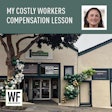

The recession caught many businesses off guard, presenting new challenges, including, but not limited to, lower and slower sales.
As a result, cash sufficiency has become a problem for many companies. For the typical NWFA distributor member, cash now represents only 2.3 percent of total assets—a position that does not leave much room for error. So, most companies have looked at reducing "cash traps," particularly inventory. While reducing inventory is a worthy goal, it can be dangerous and may trigger further sales declines by creating more out-of-stock situations. To avoid this, a company needs to understand the relationship between inventory reductions and sales declines, as well as how inventory can be reduced without impacting sales volume.
Shifting Sands
Every company needs sales volume to survive. It also needs cash to pay its bills. While these two concepts usually go hand-in-hand, sometimes they do not. To understand the trade-offs between the two, it is useful to look at some of the financial results for the typical NWFA distributor member:
- Net Sales: $12,000,000
- Net Profit Before Taxes: $180,000, or 1.5 percent of sales
- Inventory: $1,450,000, or 53.2 percent of the company's total asset investment
- Cash: $62,500, or 2.3 percent of total assets
Clearly, the magnitude by which inventory dwarfs cash in this situation suggests a major opportunity for reallocation of assets. If the company could reduce its inventory by 5 percent, which is certainly within the realm of possibility, then inventory could be reduced by $72,500. If all of the inventory reduction were put into cash, then cash would be increased by 116 percent. From a cash flow perspective, it is an attractive, and possibly even essential, shifting of funds.
At the same time, even a modest 5 percent reduction in inventory has the potential to lower sales volume if the reduction lowers the business's service level. The table on page 24 displays the challenges associated with an inventory reduction by looking at current results from the NWFA Profit Improvement Report and three different scenarios. Expenses are broken into three categories. Inventory Carrying Costs (ICC) is the cost of maintaining inventory, such as interest, property taxes and the like. The ICC factor is assumed to be 12 percent of inventory, so these costs are $174,000 (inventory of $1,450,000 times 12 percent). Variable costs such as commission and bad debts are assumed to be 4 percent of sales, or $480,000. All other expenses are in the fixed (or overhead) category.
The first column of numbers shows the results for the typical NWFA distributor member. The second column explores a 5 percent reduction in inventory that is achieved without impacting sales. The result is that inventory is reduced by the $72,500 figure mentioned earlier. With no sales reduction, the ICC figure drops by the same 5 percent as the inventory reduction. The result is a profit increase of $8,700. Cash has been increased dramatically and profit is up slightly—a perfect scenario.
The third column builds a scenario in which the 5 percent reduction in inventory results in sales declining by the same 5 percent (the exact impact on sales would obviously vary from company to company). Even with a very modest sales decline, the impact on profit is severe. The reduction in ICC is more than offset by the drop in sales and drives profits down to $80,700, a 55.2 percent drop.
The last column determines the sales decline that will exactly offset the 5 percent reduction in inventory from a profit perspective. As can be seen, if sales fall by only a miniscule 0.4 percent (0.403 percent to be precise), then the entire profit impact of the inventory reduction is offset. The firm has more cash but has not enhanced profits.
The unknown factor, of course, is the extent to which sales will fall because of reduced inventory. That depends on the methods your company uses to drive the inventory reduction. For too many businesses, the methods tend to be ham-handed and end up doing more harm than good.
Firm Foundation
In an ideal world, a company could have its cake and eat it too, lowering inventory with no negative impact on sales. There is potential to achieve this seemingly elusive goal. Too often, though, companies cut inventory across the board with a "stop buying" edict. The impact is to drive the investment in A items well below the levels needed to support sales. The business then suffers both a sales decline due to being out of stock and a hit to its reputation.
At the other extreme, a company may choose to focus only on the slowest-selling items. This is a great long-term strategy, as many D items are pockets of excess inventory; however, because the D items are, by definition, slow selling, the inventory reduction process is agonizingly slow.
Ultimately, companies need to break the inventory investment into pockets of opportunity. The following figures show how much inventory can be reduced without suffering a sales decline.
- A Items: No reduction
- B Items: 1 to 2 percent reduction
- C Items: 5 percent reduction
- D Items: 10 percent reduction
Over time, this will produce the inventory reduction required to generate more cash. Given that many of the D items are duplicated in a company's product assortment, there should be little, if any, sales loss. The payout, however, will come at a modest pace, rather than quickly.
Keep it Steady
To keep a firm financial foundation, it's vital companies avoid any inventory reductions that impact sales. Given current cash levels, quick inventory reductions are a tempting short-run target, but they are a long-run impediment to success. Instead, companies would be better served to slowly eliminate redundant items. This is a strategy for all seasons that should not be abandoned when the economy improves.

































